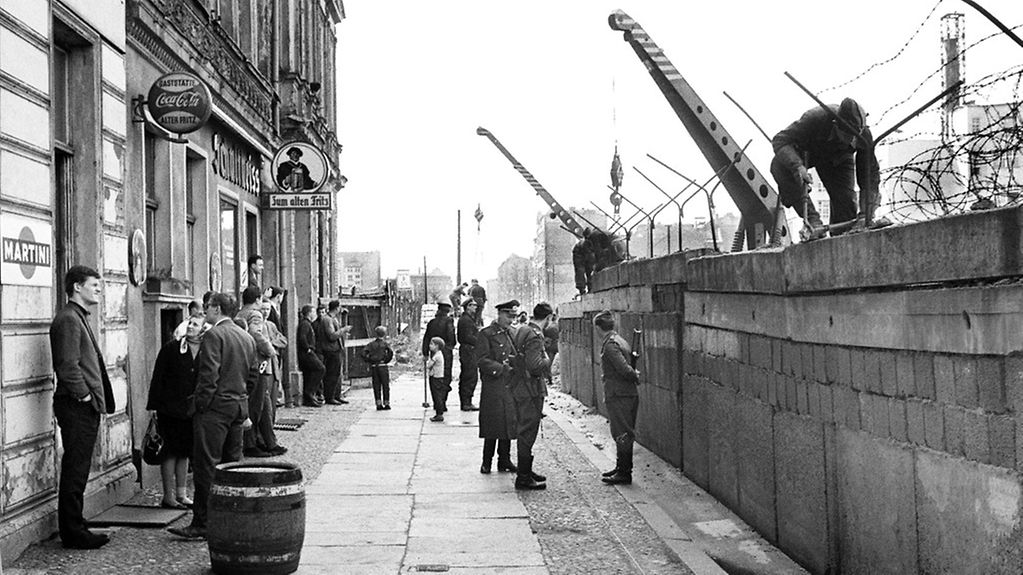Construction of the Berlin Wall on 13 August 1961
Germany has now been reunited for longer than it was divided by a border that ran through the country, but the construction of the Berlin Wall on 13 August 1961 is still a reminder to us – it was a dark day for Germany. Overnight, families were torn apart and future plans destroyed.
3 min reading time

Building the Berlin Wall on 13 August 1961. Overnight families and friends were divided.
Photo: Bundesregierung/Lehnartz
It was a Sunday morning. Lots of people in Berlin were still fast asleep when East Germany's "National People’s Army" troops, border police, police officers and members of the so-called workers’ brigade groups began to close off roads and rail tracks.
Construction workers erected barbed wire along the borders between East and West Berlin. The paving was torn up on the roads that linked East and West. Every transport connection was closed off.
"Nobody intends to build a wall"
The people of Berlin were taken completely unaware. On 15 June, Walter Ulricht, the head of state of the German Democratic Republic had declared, "Nobody intends to build a wall." Less than two months later, nothing could have been further from the truth.
The wall sprang up overnight. Families, friends and neighbours were torn apart from one day to the next. There were dramatic scenes as individuals desperately tried to cross the border.
Fleeing entailed mortal danger
Soon, the first people paid with their lives as they attempted to flee. On 24 August 1961, only 11 days after the border was sealed off, Günter Litfin attempted to swim across the Osthafen close to Charité Hospital to West Berlin. He was discovered and shot by transport police officers.
Little by little, the barbed wire was replaced by a heavily armed border that ran through and around Berlin for almost 43.1 kilometres. The East German leadership built the wall to prevent people fleeing to the West. Tens of thousands of people had already voted with their feet. They fled because they rejected the policies pursued by the governing SED in the East or because of the difficulties of maintaining basic supplies of goods and services for the people in the socialist state.
Yearning for freedom
The East German leadership managed to prevent mass defections. But the people still yearned for freedom. In spite of barbed wire, landmines and the order to shoot potential defectors on sight, people never stopped trying to get over the wall and across the German-German border. Not even the draconian prison sentences imposed for any attempt to escape could stop them.
More than 40,000 citizens of the German Democratic Republic managed to flee over the wall or across the border between the two German states. At least 260* men and women paid with their lives, when they failed to escape. At least 140* people died at the Berlin Wall.
The last fatal shots at the Berlin Wall were fired on 5 February 1989 – a good nine months before the Berlin Wall fell. The peaceful revolution and the fall of the Berlin Wall on November 1989 ended this unhappy chapter of German history after 28 years.
* Higher numbers of victims quoted elsewhere include contested categories of cases or are based on unverified sources.
The German government encourages memorial work and coming to terms with the past
The division of Berlin and of Germany is history. Nevertheless, it is important to keep alive the memory of the unjust dictatorship in the German Democratic Republic, and to pay tribute to the victims. That is why the German government supports memorial sites and other places that remember the division of Germany and the victims of that division.
One central memorial site is the Berlin Wall Memorial. It was built in 1998 on what used to be the border strip at Bernauer Strasse. The Marienfelde Refugee Center Museum is Germany’s main museum that commemorates people fleeing and leaving the German Democratic Republic. Many people also visit the permanent exhibition in what is colloquially known as the Palace of Tears, the former border crossing point at Friedrichstraße station. Visitors can see how the border control worked – with an original passport control booth.